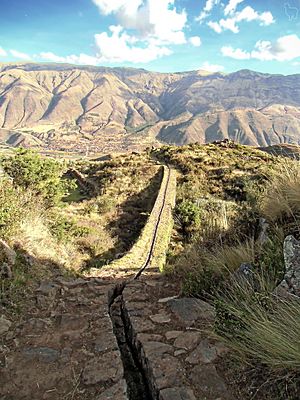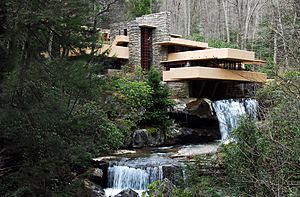Incan aqueducts facts for kids
The Incan aqueducts were amazing water systems built by the Inca people. These structures helped the Inca grow more crops and gave their cities drinking water and baths. The Andes mountains often had little water, so the Inca needed smart ways to manage water. This helped them grow and thrive along the coast of Peru. Many of these ancient structures still exist today. They show how skilled the Inca were at water engineering and building.
The Inca got water mostly from nearby rivers. They also brought fresh water down from mountain springs. They learned that by moving water from rivers, they didn't have to worry about dry spells. This also helped plants grow faster. Workers dug tunnels through mountains and cut channels into cliffs to complete these projects.
When a lot of mountain snow melted, the extra water could cause floods. The Inca collected this floodwater in huge stone reservoirs. They then channeled this stored water to their cities and religious places.
Contents
- Early Discoveries of Inca Waterways
- Machu Picchu's Water System
- Moray's Unique Terraces
- Tipón's Ancient Waterways
- Pisac's Sacred Water Features
- Pumpu's Elite Water Access
- Huánaco Pampa's Grand Plaza and Pools
- Tomebamba's Extensive Networks
- Caranqui's Unique Dual Channels
- Inca Influence on Modern Design
- See also
Early Discoveries of Inca Waterways
The first written records of Incan water systems came from Spanish explorers in the 1500s. One of these explorers was Pedro Cieza de León. In his travel books about Peru, he wrote about seeing a large wall east of Cusco. Experts believe he was talking about an aqueduct at the Piquillacta ancient site. Cieza wrote:
- "Along this road there is a very large, broad wall, along the top of which, according to the natives, ran pipes of water, laboriously brought from some river and piped in with the forethought and care they used in building their irrigation ditches."
Later, in the late 1800s, American archeologist Ephraim George Squier also saw several aqueducts in Peru. He noted ones that watered gardens on the terraces of the Yucay or Sacred Valley, north of Cuzco. He also wrote about the remains of a 60-foot-high aqueduct near Lima.
Machu Picchu's Water System
Machu Picchu is the most famous and best-preserved Incan site. It has a very complex aqueduct system. Building Machu Picchu started around the mid-1400s as a special estate for nobles under Emperor Pachacuti.
Inca engineers at Machu Picchu found a clever way to collect stones. This helped them get more water from a natural spring. This spring usually only had a lot of water when mountain snow melted in warmer months. Without this idea, Machu Picchu could not have supported its people. The area got enough rain for farming, but there were few fresh water sources for daily use. Water had to travel about half a mile (749 meters) to reach the city center.
The Inca were very skilled in how they built the aqueducts. They cut canals out of single stones and lined them with rock. They also filled joints with clay. This helped stop water from leaking out.
The water from this stream fed sixteen fountains. These fountains added beauty and sound to life in Machu Picchu. They provided water for homes not directly connected to the canals. They were also used for worship and ceremonies. These fountains show that water flow was a key part of the city's design from the start. This proves the Inca had advanced ideas about city planning and managing resources.
Moray's Unique Terraces
Moray is an ancient site located between Cuzco and Machu Picchu. It is known for its three unusual, round depressions with terraced circles. Water flowed down from one terrace level to the next through vertical channels. This created a beautiful waterfall effect.
Unlike Machu Picchu, Moray did not get enough rain for farming on its own. So, aqueducts were needed to bring water from three nearby springs. Reservoirs also helped these aqueducts. This ensured a steady flow of water, even when the springs had less water.
Tipón's Ancient Waterways

Aqueducts can also be found at the ancient site of Tipón. This group of ruins is about thirteen miles east of Cuzco. It was once a special estate for the Incan elite and nobles. The aqueducts here are built on top of walls that were there before the Inca. Scholars believe these older walls were built by the Wari civilization.
After the Inca took over Tipón around 1400 CE, Emperor Viracocha sent engineers to check the site. These engineers made the existing Wari walls stronger using andesite stone. They used the special Inca technique of building with stones that fit together without mortar. They also improved the three existing canals. The Inca then made a trough on top of the wall. This trough moved water from surface and underground sources to a nearby valley. It moved over a thousand cubic meters of water. This valley was then used for irrigation. Using both ground and surface water, called conjunctive use, shows how carefully the Inca used their limited water.
This amazing engineering project needed complex surveys of the land. This is similar to what is done in modern building projects. This project relied on the work of Inca citizens. The central Inca government did not tax its people with money. Instead, they required labor for building projects. This gave the Inca the people power to support their engineering skills.
The Tipón water system also looked beautiful. While the main goal was to provide water for the estate and farming, Inca engineers also thought about how the water would look. Waterfalls and drops were joined by fountains. These fountains may have also been used for ceremonies.
Pisac's Sacred Water Features
Pisac is another royal Incan estate located near Cuzco, about 25 kilometers northeast. Many burials are found in the cliffs near Pisac. This suggests the land was considered sacred even before the Inca improved it. Emperor Pachacuti is believed to have built this estate. It is divided into four parts, all connected by detailed waterways.
The water features at Pisac start from a spring. This spring splits into two canals that feed the many baths and fountains on the estate. These water features highlight the sacred stone `huacas`. They make the moving water seem more alive and show the Inca's power over the local people. They also suggest ritual purification. This connection between water, `huacas`, and ancestors is a common theme at many Inca sites linked to Pachacuti.
Pumpu's Elite Water Access
The site of Pumpu was an administrative center near Chinchaycocha (Lake Junin), the largest lake entirely in Peru. It has three water features. An Incan bath and a water holding tank are connected by a 1-kilometer-long open canal. This canal runs through the main plaza. The bath is small and located in a housing area. To the west, the holding tank is a rectangular reservoir about 1 meter deep. All these water features seem to have been only for the elite members living in the housing district.
Huánaco Pampa's Grand Plaza and Pools
Huánaco Pampa was another Incan provincial site. It was a large settlement built around a big plaza. On the east side, there are baths similar to those at Pumpu. However, Huánaco Pampa also has a pool. A series of open and covered canals and channels feed the baths and pool. Between these features are large walled depressions. Some of the fine stonework in the area is seen at the water's entry points. Trapezoid-shaped openings, steps, and niched walls decorate this detailed water system. The pool, which some think was a sunken garden, is filled by water from a nearby spring. The abundant water divided the estimated 3,500 buildings built by Topa Inca Yupanqui.
Tomebamba's Extensive Networks
Topa Inca built Tomebamba, and his son Huayna Capac imagined it as a second capital alongside Cuzco. This city had very extensive water systems, some of the most impressive archeologists like Max Uhle had ever seen. Most of the ancient city is now covered by modern buildings. However, there is still proof of wide drainage systems, canals, baths, a pool, and even a man-made lake. The lake is below terraces that lead up to a building believed to be a sun temple. Some stone features go with these complex water systems, such as a semi-circle cut stone and a large cross-shaped stone with a pool in its center. All these features are fed by tanks and tunnels found throughout the site. Some archeologists believe all these detailed waterways might have been a filtration system.
Caranqui's Unique Dual Channels
The remains of Caranqui, possibly the last imperial settlement of the Inca Empire, show signs of important water architecture. As part of the empire's northern expansion, Huayna Capac showed complete control over water. After a terrible event where local men were drowned in the nearby lake, Yaguarcocha, the Emperor built a huge water system. This system was designed to impress the empire's most important people.
Like most Incan settlements, Caranqui had canals. But Caranqui's canals were unusual. Open and closed stone-walled channels ran side-by-side. This was different from what had been seen before. Some archeologists think that having two channels running next to each other in the city center meant they carried two different liquids. Also, throughout the city, there are what look like pothole-like structures. These were meant to carry extra water away from the city. Some of these drains flowed water into what is thought to be a semi-underground temple. This temple has multiple floors where water drains through, collecting in a large space likely used for big performances. This temple is important because it is much larger than most baths or pools in earlier Incan buildings. It also has historical importance. This temple is surely the "estanque" (a pool) that Pedro Cieza de León wrote about in his 1553 book Crónica del Perú.
Inca Influence on Modern Design
Frank Lloyd Wright's Inspiration
The famous American architect of the 1900s, Frank Lloyd Wright, was interested in Incan architecture. The Fallingwater house in Pennsylvania is a good example of this. When you look closely, you can see parts of Incan architecture in its modern design. As its name suggests, the house is known for how it uses water. Channels, pools, and fountains run throughout the house, just like in Incan royal estates.
Having water flow through rocks was a big part of the Inca's spiritual and cultural beliefs. Many fountains at Fallingwater are large rock structures with channels flowing through them, similar to those at Incan sites. Along with water features inspired by the Inca, Fallingwater also uses large natural rocks. In Incan culture, these large natural rocks, sometimes called "living rocks," held a lot of spiritual meaning.
See also
 In Spanish: Acueductos incas para niños
In Spanish: Acueductos incas para niños


